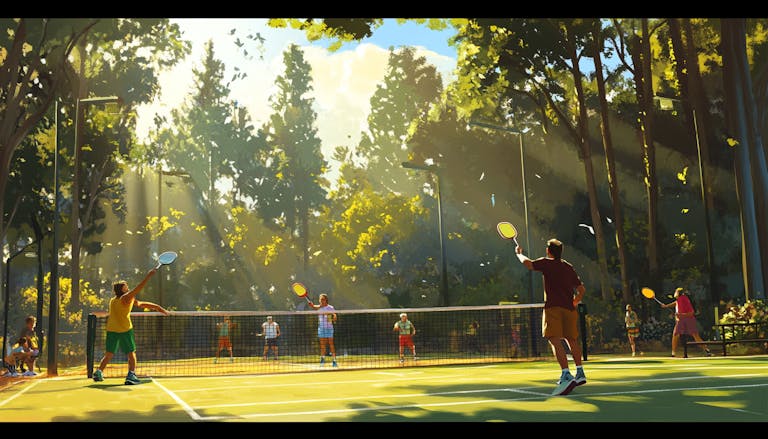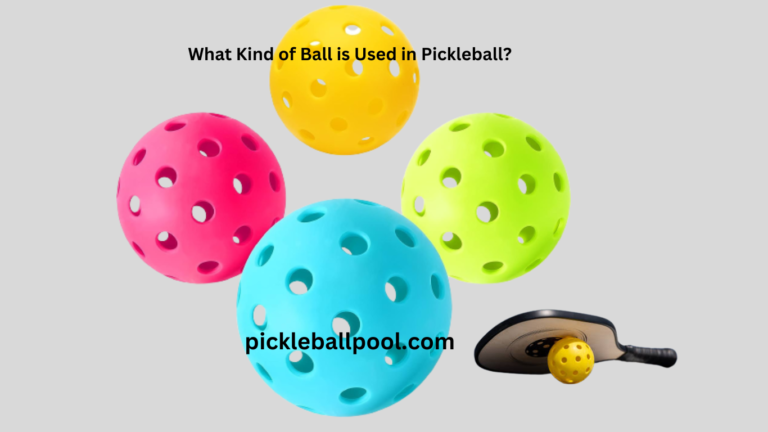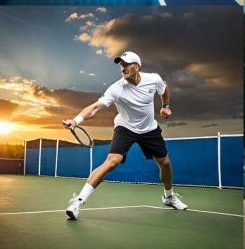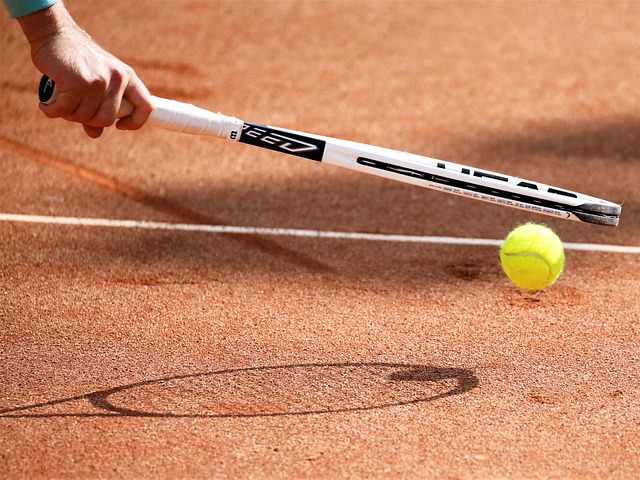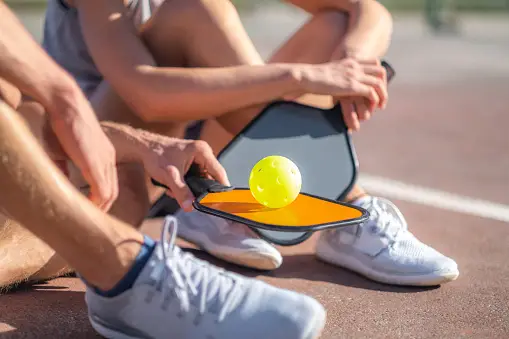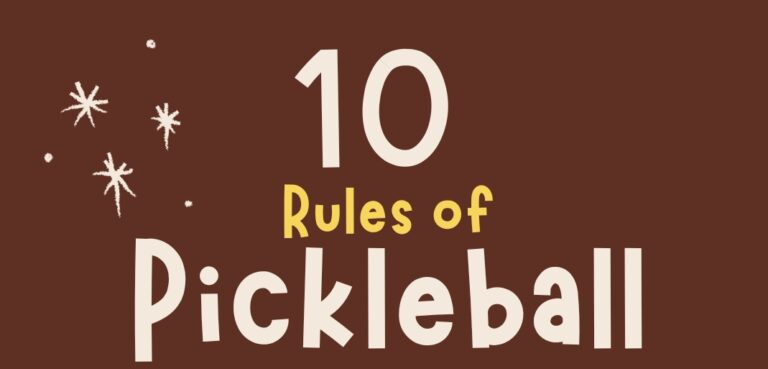The Secret to Playing Pickleball on Grass: Expert Tips and Essential Guide
When venturing into grass court pickleball, understanding the unique challenges becomes crucial. The USA Pickleball Association acknowledges that surface conditions dramatically impact gameplay. Unlike traditional hard courts, grass introduces unpredictable bounce and uneven terrain that demands strategic adaptation.
Successful play requires keen awareness of lawn characteristics. Players must anticipate reduced ball speed and limited predictability caused by weeds and poor ground conditions. Developing a nimble approach involves modifying shot techniques, maintaining lower center of gravity, and using softer strikes to compensate for irregular court surfaces.
Strategic gameplay demands heightened focus on footwork, precise ball placement, and minimizing potential disruptions from inconsistent lines and terrain variations. By embracing these adaptive strategies, players can transform potential challenges into opportunities for innovative pickleball performance.
Is Playing Pickleball On Grass Challenging?
Pickleball on grass presents a unique set of challenges for outdoor court enthusiasts. While some determined players might attempt this playing option, understanding the terrain nuances is crucial. The pros and cons of grass pickleball require careful consideration, as the surface dramatically alters traditional gameplay dynamics.
Navigating the challenging environment demands adaptability and strategic thinking. Players must adjust their techniques to compensate for unpredictable ball bounce, uneven ground, and reduced speed. By embracing the unconventional surface, pickleball enthusiasts can transform potential limitations into opportunities for skill development and innovative play strategies.
1. Not Enough Bounce
Pickleball players face significant bouncing challenges on grass surfaces, especially those full of holes or with inconsistent terrain. The ball behaves radically different from hard surfaces like cement or asphalt, creating erratic bounce that demands exceptional game adaptation and a harder approach to playing.
Outdoor pickleball on short grass, hard-packed dirt, or variable turf requires skills akin to a baseball infielder’s technique. Athletes must navigate wonky landscapes, anticipating unpredictable tennis ball trajectories that make predicting movement tougher. Whether in indoor or outdoor settings, players must master proper movement across uneven surfaces, transforming the pickleball experience into a dynamic challenge with greater bounce potential and an exception-al test of athletic skill.
2. Slower Momentum and Uneven Terrain
Pickleball on grassy terrain demands exceptional reflexes and adaptive speed due to risky terrain characteristics. Players must adjust their movements when hitting the ball at the right time, especially on surfaces impacted by rainfall or dew that can make the ground slippery and worsen playing conditions.
Hard surface courts like badminton or concrete are designed for smooth momentum, but grass surfaces force athletes to develop unique strategies. Traction becomes challenging, causing players to move quickly yet stay low, holding down their center of gravity. The dry grass environment forces harder techniques, with bounce slower and zip reduced, ultimately going against traditional court game constructions.
4. Slippery when Set
As grass isn’t an ideal playing surface for pickleball. Unlike a standard pickleball court, grass pickleball courts can be slippery and unpredictable. The pickleball ball doesn’t bounce well on grass, making it difficult to maintain a consistent play style. However, if you want to play pickleball outdoors and don’t have access to a proper court, you can play pickleball on grass with some modifications. Using a portable net and a rubber ball designed for grass play can help.
Artificial turf is another option, as pickleball on artificial turf provides better bounce than natural grass. While it may not be ideal, pickleball can be played on grass for casual games. The Lawn Pickleball Association even promotes this variation of the sport. Remember that the bounce on grass won’t be the same as on a standard pickleball court, so adjust your expectations and enjoy a more relaxed version of this popular game.
5. Court lines are hard to see
The world of pickleball demands precision, and when players transition from traditional courts to grassy terrains, unique challenges emerge. Grass surfaces introduce unexpected complexity to the game, particularly when it comes to line visibility and game dynamics. Unlike concrete or asphalt playing areas, natural surfaces create a visual obstacle course that tests players’ spatial perception and communicative skills.
When shots are made and players attempt to determine boundaries, the surface becomes a critical factor in game integrity. Difficult markings on grass can lead to disagreements and reduce the overall enjoyable experience. The potential for unclear line demarcations means players must rely on heightened linguistic and referential communication, transforming what should be a straightforward sport into a more nuanced cognitive challenge.
Painting precise lines becomes an art of perception, where visual boundaries are less clear and straight, forcing participants to involve themselves more deeply in game interpretation and spatial awareness.
Is playing pickleball on grass offers some advantages
Pickleball enthusiasts often overlook the unique charm of playing their favorite sport on a grass surface. While traditionalists might view this as challenging, there’s an intriguing alternative game experience waiting to be explored. The softer surface offers a surprising twist to conventional playing techniques, presenting both subtle challenges and hidden advantages that can transform your typical court dynamics.
1. Easy to set up for casual game
Looking for a casual way to enjoy pickleball? With just a large open space like a backyard or local park, you can set up your game almost anywhere. The beauty of grass courts lies in their choice of enough playing areas, allowing players to create impromptu match zones without strict boundaries.
I’ve personally discovered that using natural grass surfaces not only provides a unique playing experience but also offers gentler impact on your joints, making it an easier alternative to traditional hard courts. Whether you’re a weekend warrior or a spontaneous player, the flexibility of grass-based pickleball means you’re never far from a potential match location.
2. The ball travels slower and is easier to control
The ball travels slower and is easier to control. To set up a grass pickleball area, you can use a portable pickleball net and adjust the pickleball court dimensions to fit the space available. The grass may affect the bounce of the ball, but this can add an interesting twist to the game of pickleball. A plastic ball designed for outdoor use works best, as it’s more durable and less affected by wind. Grass causes the ball to bounce slower.
While the ball will bounce differently than on a hard surface, players can quickly adapt their technique for recreational play. To make pickleball work on grass, ensure the surface is even and mowed short. You can play a casual game with friends using a portable pickleball set, which includes paddles, balls, and a net. Although it’s not ideal for competitive play, a court on grass can be a fun way to enjoy this sport in a park or backyard setting.
You may like to read: 7 Best Pickleball Balls for Cold Weather
How to play pickleball on Grass
Playing pickleball on grass requires some adjustments to your technique and setup. Here are some expert tips to enhance your experience:
1. Adapt Your Shots
Grass surfaces affect ball bounce, making it less predictable. To compensate, focus on hitting the ball before it touches the ground. Add a bit more power to your shots while maintaining precision and control.
2. Adjust the Net Height
Raise the net to match the height of the tallest player on the court. This ensures fairness and accommodates the unique dynamics of playing on grass.
3. Establish a No-Spike Zone
To prevent aggressive spiking on grass, create a 5-foot no-spike zone on either side of the net. This rule encourages strategic play and minimizes the impact of uneven surfaces.
4. Try Sandy Pickle
Consider playing Sandy Pickle, a variation of pickleball tailored for soft surfaces like grass. It offers a fun and adaptable alternative for players in non-traditional settings.
5. Maintain the Grass Court
Regular maintenance is crucial for a consistent playing surface. Use a lightweight rake to realign artificial fibers or smooth natural grass, improving traction and overall playability.
6. Install Boundary Fencing
Prevent balls from rolling out of bounds by installing a fence. Temporary fencing or a permanent chain-link fence can effectively keep the game contained.
7. Set Up a Home Pickleball Court
If you’re creating a grass pickleball court at home, aim for a space that’s at least 30 feet wide and 60 feet long. Use the pickleball net as a central guide to mark out the boundaries and court layout.
What Changes Were Made As Grass Pickleball Became Sandy Pickle?
You can now enjoy playing pickleball on grass, at the beach, or even in your own backyard with Sandy Pickle! Below is a concise overview of the game’s rules.
Smaller Court Dimensions
Pickleball’s transformation on grass and sand demanded radical adaptation of traditional game specifications. The players’ limited movement on softer surfaces inspired a proprietary design that accommodated new dimensional challenges. Sandy Pickle emerged as a unique variant, adjusted to ensure every shot becomes a volley due to reduced ball bounce, fundamentally reimagining court configuration with precise baseline measurements of 16′ for singles and 18′ for doubles.
The modified game introduces smaller boundaries with intricate width measurements: singles courts spanning 13’6″ (4.1 meters) and doubles extending to 16’8″ (5.1 meters). By eliminating the traditional center line and net specification, Sandy Pickle creates a fluid, responsive playing experience that radically departs from standard pickleball comparison, transforming how athletes engage with the game’s surface dynamics and speed constraints.
Adjustable Net Height
Pickleball’s traditional height demanded radical modification as the game evolved onto different surfaces, introducing a revolutionary adaptation that goes beyond standard measurements. Players now experience a net configuration that can accommodate diverse skill divisions, transforming the court dynamics from recreational to tournament levels with unprecedented flexibility.
The innovative approach introduces an approximate net setting that can be set between 36 inches and 6 feet, creating optional modifications that recognize individual player characteristics. This modified system ensures more responsive and inclusive play, allowing dynamic adjustment that respects the unique variability of player heights and playing styles across different competitive specifications.
No-Spike Zone
Pickleball’s innovative “No Spike Zone” introduces a unique spatial restriction that transforms gameplay dynamics. Extending 5 feet from the net on each side, this zone mirrors the familiar “kitchen” concept, creating a strategic area that challenges players to navigate carefully during serve and return interactions.
The zone imposes critical limitations: during serve, players must make their return from behind this boundary, and at all other times, the only constraint is that no part of the paddle may extend above the net’s top when contact is made with the ball. This clever design prevents aggressive spiking and maintains a balanced, strategic approach to the game.
No Bounces
Balls experience significant bounce challenges on sand and grass, compelling players to develop a unique adaptation of traditional gameplay. In Sandy Pickle, a fascinating hybrid sport merging elements from pickleball, badminton, and volleyball, every shot demands immediate hit before the ball touches the ground.
The innovative 1-pass rule in doubles play introduces an exciting dynamic where a player can bump or pass to their teammate, who must then send the ball over the net on the subsequent shot. These longer, volley-only rallies create a fast-paced experience that’s arguably as fun to watch as it is to play, transforming traditional court sports into a more dynamic and engaging competition.
Serves are made from behind the baseline
The shift from grass pickleball to sandy pickleball introduced a fascinating evolution in gameplay. One of the most notable differences lies in the way serves are performed. In this new variation, players execute their serves from behind the baseline, with no limitations on where the ball can be hit—whether to the left, right, or center of the court. Unlike traditional pickleball, players are also allowed to perform an overhead serve, which adds a layer of skill and strategy to each match.
The rules have been fine-tuned to accommodate the sandy surface. If the ball lands in the no-spike zone or outside the court boundaries, the serve is considered “out.” However, if the ball hits the net but stays within bounds, it is called a “let,” and the serve is repeated. The player continues serving until they lose a point, at which point the opponent takes over. This flow of play also extends to doubles, where the serve alternates between sides after each serving opportunity. These adjustments keep the game dynamic and enjoyable for players of all levels.
Scoring
Pickleball’s traditional scoring framework undergoes a nuanced transformation in Sandy Pickle, where games are played to 11 points with intricate scoring mechanics. Players and teams can only earn points while serving, creating a strategic environment where winning requires more than just skill. The unique approach allows the receiving side to take over service, with players needing to call out the precise score – an example being 7-6-1 – which reflects the 2 additional numerical components that track service transitions and strategic positioning.
What Type Of Pickleball Is The Best For Grass?
When venturing onto grass surfaces, selecting the perfect pickleball becomes a nuanced challenge of dimensional precision and aerodynamic expertise. Outdoor pickleballs are engineered with durable construction that withstand the rougher terrain, featuring thick walls and a robust one-piece design. The material strength ensures the ball can handle unpredictable wind and environmental challenges, with careful compare and measure of its metric characteristics.
Consider the weight and diameter metrics: a typical outdoor ball weighs precisely 25.5 grams (0.9 ounce) and spans 2.897 inches (7.36 centimeter), distinctly larger than indoor variants. Brands like TOP, Dura, and ONIX – approved by the USA Pickleball Association for tournament play – offer smaller holes that minimize wind affect, creating standard visual and chromatic variations. The color palette of yellow, green, or orange enhances appearance, while ensuring official certification and validation for competitive play.
The best pickleball strategies for playing on grass
When playing on grass, your pickleball strategy demands adaptability and precision. Get to the kitchen quickly, positioning yourself strategically to control the game’s tempo. Communicate constantly with your partner, ensuring synchronized movements that exploit the unpredictable grass surface. Hit high percentage shots that minimize errors on the uneven terrain, and practice patience as the ball’s bounce will differ significantly from indoor or hard court play.
Your offensive approach should focus on tactical precision: use your forehand whenever possible, as it provides more control and consistency on grass. Go for your opponent’s feet with strategic placement, making it challenging for them to return shots effectively. Hit behind your opponent to create confusion and open unexpected angles. Let the out balls go to avoid unnecessary risks, and maintain a strategic mindset that prioritizes smart, calculated play over aggressive, high-risk maneuvers. By understanding grass court dynamics, you’ll transform potential surface challenges into competitive advantages.
Conclusion
In conclusion, ““can you play pickleball on the grass” Pickleball on grass isn’t just a game; it’s a social connection that bridges physical distances between neighbors and family. The exciting alternative to traditional courts offers a thrilling adaptation of the sport, turning your home lawn into a vibrant space of communication and enjoyment.
As people increasingly get ghosted by digital phones and internet distractions, this friendly revival of outdoor play brings back the golden days of genuine interaction, creating softer, more uneven but uniquely memorable experience. With the right footwear and paddles, you’ll navigate the challenges of grass surfaces, transforming your backyard into a closer gathering space that celebrates nostalgia and variety.
FAQs
Can you play pickleball on a grass surface?
Yes, pickleball can be played on a grass surface, though it may affect the bounce of the ball. Grass is less common compared to other surfaces due to its unpredictable nature and maintenance challenges.
Does pickleball bounce on turf?
Yes, pickleball bounces on turf, but the bounce is typically lower and less consistent than on hard surfaces. Turf courts are suitable for recreational play and can be a fun alternative.
What is the best surface to play pickleball on?
The best surface for pickleball is a smooth, hard court made of concrete or asphalt with a specialized coating. This ensures optimal ball bounce, player movement, and durability.
What color ball for outdoor pickleball?
For outdoor pickleball, bright colors like neon yellow, green, or orange are recommended. These colors enhance visibility against natural outdoor backdrops.
Can pickleball be played on synthetic grass?
Yes, synthetic grass is another option for pickleball. It offers better consistency than natural grass and is less slippery, but it still doesn’t match the bounce and speed of hard courts.
Can you play pickleball on a tennis court?
Absolutely! Many tennis courts are converted into pickleball courts by using portable nets and temporary line markings. This is a popular and practical way to enjoy pickleball in existing facilities.
Can you play pickleball on a tennis court?
You can definitely play pickleball on a tennis court. but you have to make some amendment.

